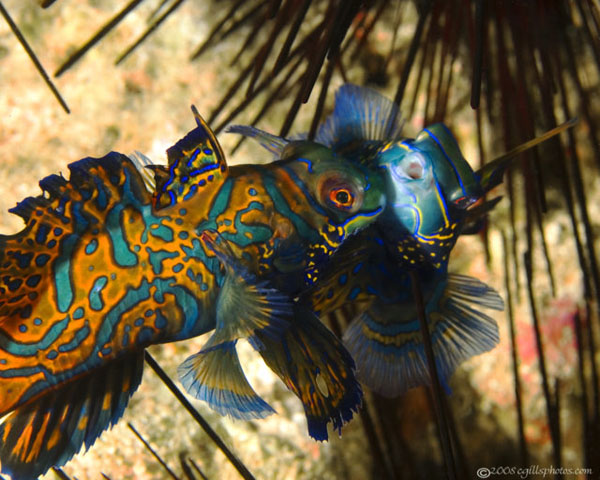
 |
|---|
|
Image © Cindy Abgarian FIGHTING MANDARINFISH Ah, the beautiful little fish that conjures up dreams of dusk dives on pristine Indonesian reefs and catching the elusive pair engaged in their mating dance. Well as luck would have it, the group’s designated Mandarinfish dusk dive resulted in a number of us sitting for 40 minutes in mucky waters, catching quick glimpses of singles as they darted here and there between the rubble bottom, but no mating behavior. Skunked. Oh well, I thought, another trip to Indonesia and no Mandarin photo. Fast forward to my extended stay in Ambon following the boat trip. This time Maluku divers guaranteed Mandarins (Synchiropus splendidus), not mating, but visible during daylight hours. We dropped into familiar territory on a site referred to as Laha, in the port of Ambon. Instead of heading South, as I had done every time in the past, we were directed to head north and actually go under the jetty, continuing on to the other side to see the Mandarin Dragonets. Along with displaying the normal debris that we had witnessed on the other Laha sites, this Twilight Zone, as aptly named by some, also had a gross amount of dead fish carnage strewn about, thanks in part to the local fish processing plant. This along with the filtered light coming through the water column and abundant eels slithering here and there definitely gave the site an eerie, graveyard appearance - one that even Indiana Jones might try his best to avoid. However we bravely ventured forth waiting to see what marine life would want to call this home, and finding frogfish and a Blue Ring Octopus, along with other seemingly alien life forms, en route to our Mandarinfish. The guide motioned to a rubble area about six feet square, in a depth less than 25 feet of water. Strewn over the top there were, tip to tip, numerous very long spined black sea urchins, and sure enough, down among the spines one could see the fugitive little Mandarinfish darting in and out of the shadows into the few beams of light tapering down from above. No wonder the little darlings enjoyed this safe hangout! After trying for several minutes to photograph single ones through the spines, I noticed, several feet over, that there appeared to be a pair rising off the bottom and mating. What luck! As I shifted into position to hopefully try and capture the event, I realized with horror that they were not mating, but involved in turmoil of some kind. Instead of sharing side-to-side caresses, one had a mouth grip on the other and appeared to have no intentions of giving up. As my shutter clicked, I began to wonder if I was going to witness a duel to the end. Fortunately that was not the case (as I was later informed could be possible between males of this species), the pair eventually did break off, each swimming slowly away, once again in the shelter of the spines. After witnessing such behavior my adrenaline was flowing, especially once I turned and realized that my fellow divers had left me, all alone in this spooky place, while they continued their quest in pursuit of other subjects. Back home the question arose - was the event I witnessed a territorial dispute of two males? Putting the question out to those in the know, Dancingfish/aka Linda Cline offered her thoughts, and suggested I put the query to the masses. It appears, based on the physical characteristics of the two, that what I may have recorded was not two males battling, but rather a larger female attacking a smaller male, as they can be known to do. Who’d a thought? Regardless, the witnessing of this behavior was indeed worth the trip into the Twilight Zone.
|
|---|